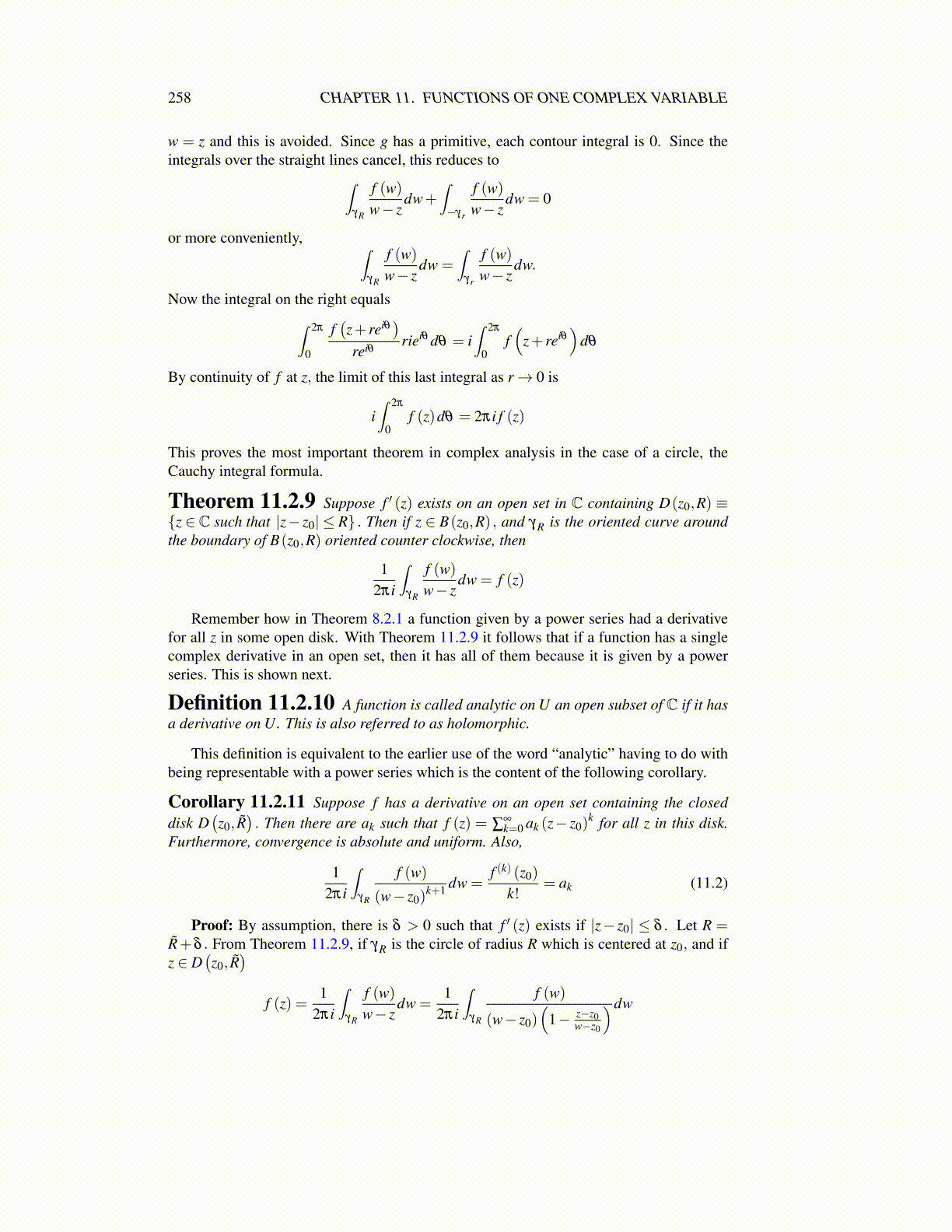
258 CHAPTER 11. FUNCTIONS OF ONE COMPLEX VARIABLE
the first time. Then this determines the desired orientation on each of the contours similarto the ones in Theorem 11.2.9. The rest of the argument is the same. There is a primitivefor f on each of these contours because f ′ exists on a convex set containing the contourand its inside, so the integral over the contour is zero. Then adding these together, it is arepeat of the proof of Theorem 11.2.9.
Obviously these theorems are not the best possible. For general versions of this, seeRudin’s book Real and Complex Analysis or my on line book Calculus of Real and Com-plex Variables. The latter treatment depends on a very general Green’s theorem and usesthe Jordan curve theorem. What is given here is sufficient for the applications of interest inthis book.
11.3 Isolated SingularitiesThis is about functions which are analytic near a point z0 but possibly not analytic at thepoint. This point z0 is called an isolated singularity.
Lemma 11.3.1 Suppose f is analytic on B̂≡B(z0,r)\{z0}. Then f can be defined at z0such that the resulting function is analytic on B(z0,r) if and only if limz→z0 (z− z0) f (z) =0. Such a z0 is called a removable singularity.
Proof: It is clear that if f (z0) can be chosen to make the function analytic then it followsthat limz→z0 (z− z0) f (z) = 0.
Suppose then that this limit condition holds. Consider h(z)≡ (z− z0)2 f (z) ,h(z0)≡ 0.
Then
h′ (z0)≡ limz→0
h(z)z− z0
= limz→0
(z− z0)2 f (z)
(z− z0)= lim
z→0(z− z0) f (z) = 0
Thus h(z) is analytic near z0 with a power series of the form ∑∞k=2 ak (z− z0)
k and sof (z) = ∑
∞k=2 ak (z− z0)
k−2 for all z ̸= z0 and hence we can take f (z0) ≡ a2 and the re-sulting function is given by a power series and is therefore, analytic by Theorem 8.2.1.
Theorem 11.3.2 (Casorati Weierstrass) Suppose f is analytic near z0 and for B̂≡B(z0,r) \ {z0} , f
(B̂)is NOT dense in C. This means there is w where B(w,δ ) has no
points of f(B̂). Then near z0 there is an analytic function g(z) such that for z near z0,
f (z) = g(z)+∑mk=1
bk(z−z0)
k . In words, this says that f has a pole at z0 or else is equal to an
analytic function near z0 unless f(B̂)
is dense in C.
Proof: It is clearly true if limz→z0 (z− z0) f (z) = 0 from the above lemma. This is thecase where z0 is removable, and in this case, there is no sum ∑
mk=1
bk(z−z0)
k , just an analytic
function g(z).Now suppose B(w,r) contains no points of f
(B̂). Then consider 1
f (z)−w which is an-alytic near z0. For z close enough to z0, | f (z)−w| is larger than some δ since otherwise,there would be zn→ z0, f (zn)→ w so from Lemma f (zn) ∈ B(w,r) if n sufficiently large.Hence limz→z0 (z− z0)
1f (z)−w = 0 and so from Lemma 11.3.1, 1
f (z)−w = h(z) where h is
analytic near z0. Say h(z) = ∑∞k=0 ak (z− z0)
k.